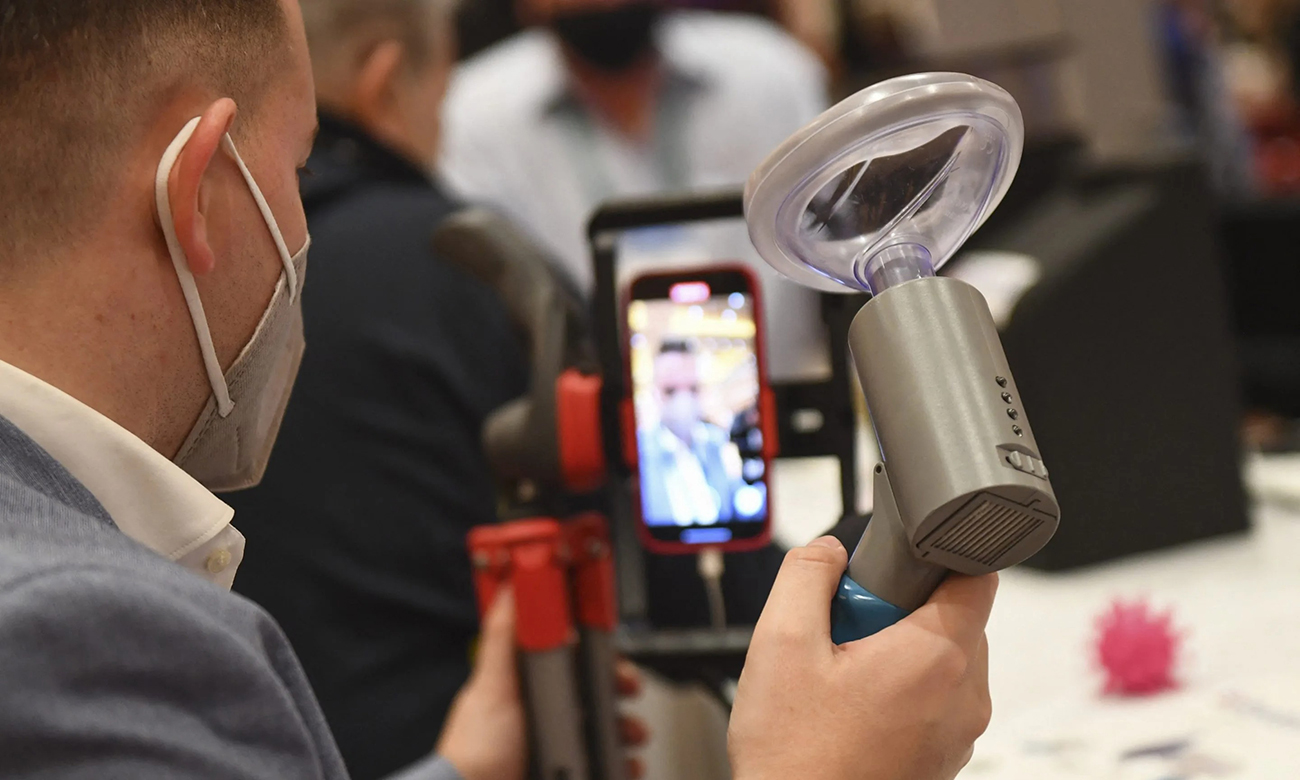
在全球疫情的恐怖氛圍中,,數(shù)字健康產(chǎn)業(yè)爆發(fā)了。新冠病毒危機(jī)為預(yù)防性護(hù)理的創(chuàng)新性發(fā)展帶來了千載難逢的好機(jī)會,。但是,,一不留神,這個機(jī)會就要從我們手中溜走了,。
政策制定者批準(zhǔn)了遠(yuǎn)程醫(yī)療的使用,,還推動了醫(yī)療設(shè)備與人工智能的結(jié)合。各國政府花了大價錢推廣居家新冠檢測,,僅美國就投入了478億美元用于在全美實施居家新冠檢測戰(zhàn)略,,相關(guān)舉措包括優(yōu)化數(shù)據(jù)分享和診斷等,人均花費約143美元,。衛(wèi)生管理人員也應(yīng)聲而動,,推出了可以減少醫(yī)療成本的數(shù)字化改進(jìn)措施,加快了家庭護(hù)理進(jìn)程,,改善了慢性病檢測,,而后者是美國死亡和醫(yī)療賬單的主要來源,。
這是一個難得一見的“馬歇爾計劃時刻”,以一種更便宜,、更有效也更具人文關(guān)懷的方式重建醫(yī)療體系,。然而,如果我們不改變現(xiàn)在的高談闊論,,繼續(xù)夸大渲染技術(shù)可以給我們帶來什么,,我們的行業(yè)將有可能白白浪費這個機(jī)會??萍冀绲膭?chuàng)業(yè)家們稱,,后疫情世代是“顛覆者”的時代,顛覆者會推翻現(xiàn)有系統(tǒng),,以全新的系統(tǒng)取而代之,,但他們是在幫倒忙。
如果在醫(yī)療保健行業(yè)也沿用硅谷“快速行動,、打破陳規(guī)”的文化,,我們將付出無法承受的代價。這種做法將影響患者的健康和安全,,危及醫(yī)院的抗逆能力,,還會損害監(jiān)管機(jī)構(gòu)的信任。
被判處11年監(jiān)禁的伊麗莎白·霍姆斯為我們敲響了警鐘,,冷酷地提醒著我們這種“顛覆性”炒作可能會給醫(yī)療保健行業(yè)帶來何種毀滅性的后果,。
我們回不去了。近四分之一的美國人因為費用問題放棄醫(yī)療,。醫(yī)療支出占美國國內(nèi)生產(chǎn)總值的20%,,預(yù)計還將繼續(xù)增長。持續(xù)的通貨膨脹只會使問題加劇,。當(dāng)前的情況不可持續(xù),。
矛盾的是,恰恰是數(shù)字醫(yī)療繁榮發(fā)展的美好承諾在破壞它的未來,。許多上市公司不久前的估值達(dá)到數(shù)十億美元,,現(xiàn)在的股價僅為票面價值的幾個百分點。他們承諾過多,,卻兌現(xiàn)不足,,浪費了數(shù)以億計的本可以用于改善病人護(hù)理現(xiàn)狀的真金白銀,還損害了監(jiān)管機(jī)構(gòu)和投資者本就沒那么堅定的信任,。
媒體炒作使情況愈發(fā)糟糕,。記者們大肆鼓吹健康科技界的童話故事,鼓吹獨角獸企業(yè)和私營企業(yè)生產(chǎn)出了能夠改變現(xiàn)有醫(yī)療系統(tǒng)的“顛覆性”產(chǎn)品。
我們以前遇到過這種情況,。有些人可能還記得早期關(guān)于人工智能將取代醫(yī)生的斷言,。2014年,,IBM宣布其沃森系統(tǒng)將徹底改變癌癥治療,。而事實上,它的人工智能甚至無法區(qū)分不同類型的癌癥,。2016年,,人工智能先驅(qū)杰弗里·辛頓宣布,放射科醫(yī)生將在幾年內(nèi)被淘汰,。事實上,,這兩個領(lǐng)域的研究工作均仍處于初期,專家們表示,,要想將上述解決方案變成現(xiàn)實還需要很多年,。
如果說夸大其詞損害信任,那么赤裸裸的欺騙則會帶來災(zāi)難性的后果,。在2014年Theranos的炒作達(dá)到頂峰時,,伊麗莎白·霍姆斯謊稱,她估值100億美元的公司,,可以用一滴血進(jìn)行數(shù)百次測試,。當(dāng)時,投資者們要求我把自己的創(chuàng)業(yè)公司搞得“更像Theranos一點”,。僅僅兩年后,,他們就讓我證明我們和Theranos完全不同!
這對行業(yè)造成了無法估量的巨大傷害。震驚失望之余,,風(fēng)投公司選擇了“更安全”的行業(yè),。監(jiān)管機(jī)構(gòu)叫停了審批。僅僅一名斯坦福大學(xué)畢業(yè)生的罪行就讓行業(yè)多年投入付之東流,。
新冠之后,,得益于政府的大規(guī)模投資和新的監(jiān)管舉措,2021年成為數(shù)字健康領(lǐng)域創(chuàng)下歷史紀(jì)錄的一年,,僅在美國,,融資就達(dá)到近300億美元。然而,,進(jìn)入2022年,,行業(yè)融資和估值急劇下降。只把原因歸咎于經(jīng)濟(jì)衰退是不夠的,,因為事實上,,數(shù)字醫(yī)療行業(yè)比其他科技行業(yè)遭受的損失更大。
如果我們沿著正確的方向,圍繞臨床級創(chuàng)新和醫(yī)療驗證協(xié)議來推動數(shù)字健康行業(yè)發(fā)展,,我們的行業(yè)是通貨緊縮的,,能更好地適應(yīng)市場趨勢。業(yè)內(nèi)下一批公司必須要長久,。要做到這一點,,我們必須培養(yǎng)誠實對話的風(fēng)氣,坦誠地討論創(chuàng)新能實現(xiàn)什么,,不能實現(xiàn)什么,。否則,我們只能在五年后醒來,,發(fā)現(xiàn)花了數(shù)千億美元,,卻沒得到任何實際價值或臨床意義。
我們需要談?wù)摰牟皇穷嵏?,而是合作,。我們要做的不是畫大餅許諾能生產(chǎn)出萬能藥,而是持續(xù)創(chuàng)新以推動可持續(xù)的,、系統(tǒng)性的進(jìn)步,,特別是要用創(chuàng)新解決蕓蕓大眾關(guān)注的健康問題。最重要的是,,我們必須認(rèn)真聽:讓醫(yī)生和衛(wèi)生管理人員的專業(yè)知識以及患者的需求來推動我們的決策,,而不是操之過急。(財富中文網(wǎng))
約納坦·阿迪瑞是Health .io的創(chuàng)始人兼首席執(zhí)行官,。今年7月,,該公司的智能手機(jī)家用腎臟測試獲得了美國食品及藥物管理局的批準(zhǔn)。
《財富》雜志網(wǎng)站評論文章僅系作者個人觀點,,不代表《財富》雜志的觀點理念,。
譯者:Agatha
在全球疫情的恐怖氛圍中,數(shù)字健康產(chǎn)業(yè)爆發(fā)了,。新冠病毒危機(jī)為預(yù)防性護(hù)理的創(chuàng)新性發(fā)展帶來了千載難逢的好機(jī)會,。但是,一不留神,,這個機(jī)會就要從我們手中溜走了,。
政策制定者批準(zhǔn)了遠(yuǎn)程醫(yī)療的使用,還推動了醫(yī)療設(shè)備與人工智能的結(jié)合,。各國政府花了大價錢推廣居家新冠檢測,,僅美國就投入了478億美元用于在全美實施居家新冠檢測戰(zhàn)略,相關(guān)舉措包括優(yōu)化數(shù)據(jù)分享和診斷等,,人均花費約143美元,。衛(wèi)生管理人員也應(yīng)聲而動,,推出了可以減少醫(yī)療成本的數(shù)字化改進(jìn)措施,加快了家庭護(hù)理進(jìn)程,,改善了慢性病檢測,,而后者是美國死亡和醫(yī)療賬單的主要來源。
這是一個難得一見的“馬歇爾計劃時刻”,,以一種更便宜,、更有效也更具人文關(guān)懷的方式重建醫(yī)療體系。然而,,如果我們不改變現(xiàn)在的高談闊論,,繼續(xù)夸大渲染技術(shù)可以給我們帶來什么,,我們的行業(yè)將有可能白白浪費這個機(jī)會,。科技界的創(chuàng)業(yè)家們稱,,后疫情世代是“顛覆者”的時代,,顛覆者會推翻現(xiàn)有系統(tǒng),以全新的系統(tǒng)取而代之,,但他們是在幫倒忙,。
如果在醫(yī)療保健行業(yè)也沿用硅谷“快速行動、打破陳規(guī)”的文化,,我們將付出無法承受的代價,。這種做法將影響患者的健康和安全,危及醫(yī)院的抗逆能力,,還會損害監(jiān)管機(jī)構(gòu)的信任,。
被判處11年監(jiān)禁的伊麗莎白·霍姆斯為我們敲響了警鐘,冷酷地提醒著我們這種“顛覆性”炒作可能會給醫(yī)療保健行業(yè)帶來何種毀滅性的后果,。
我們回不去了,。近四分之一的美國人因為費用問題放棄醫(yī)療。醫(yī)療支出占美國國內(nèi)生產(chǎn)總值的20%,,預(yù)計還將繼續(xù)增長,。持續(xù)的通貨膨脹只會使問題加劇。當(dāng)前的情況不可持續(xù),。
矛盾的是,,恰恰是數(shù)字醫(yī)療繁榮發(fā)展的美好承諾在破壞它的未來。許多上市公司不久前的估值達(dá)到數(shù)十億美元,,現(xiàn)在的股價僅為票面價值的幾個百分點,。他們承諾過多,卻兌現(xiàn)不足,,浪費了數(shù)以億計的本可以用于改善病人護(hù)理現(xiàn)狀的真金白銀,,還損害了監(jiān)管機(jī)構(gòu)和投資者本就沒那么堅定的信任,。
媒體炒作使情況愈發(fā)糟糕。記者們大肆鼓吹健康科技界的童話故事,,鼓吹獨角獸企業(yè)和私營企業(yè)生產(chǎn)出了能夠改變現(xiàn)有醫(yī)療系統(tǒng)的“顛覆性”產(chǎn)品,。
我們以前遇到過這種情況。有些人可能還記得早期關(guān)于人工智能將取代醫(yī)生的斷言,。2014年,,IBM宣布其沃森系統(tǒng)將徹底改變癌癥治療。而事實上,,它的人工智能甚至無法區(qū)分不同類型的癌癥,。2016年,人工智能先驅(qū)杰弗里·辛頓宣布,,放射科醫(yī)生將在幾年內(nèi)被淘汰,。事實上,這兩個領(lǐng)域的研究工作均仍處于初期,,專家們表示,,要想將上述解決方案變成現(xiàn)實還需要很多年。
如果說夸大其詞損害信任,,那么赤裸裸的欺騙則會帶來災(zāi)難性的后果,。在2014年Theranos的炒作達(dá)到頂峰時,伊麗莎白·霍姆斯謊稱,,她估值100億美元的公司,,可以用一滴血進(jìn)行數(shù)百次測試。當(dāng)時,,投資者們要求我把自己的創(chuàng)業(yè)公司搞得“更像Theranos一點”,。僅僅兩年后,他們就讓我證明我們和Theranos完全不同!
這對行業(yè)造成了無法估量的巨大傷害,。震驚失望之余,,風(fēng)投公司選擇了“更安全”的行業(yè)。監(jiān)管機(jī)構(gòu)叫停了審批,。僅僅一名斯坦福大學(xué)畢業(yè)生的罪行就讓行業(yè)多年投入付之東流,。
新冠之后,得益于政府的大規(guī)模投資和新的監(jiān)管舉措,,2021年成為數(shù)字健康領(lǐng)域創(chuàng)下歷史紀(jì)錄的一年,,僅在美國,融資就達(dá)到近300億美元,。然而,,進(jìn)入2022年,行業(yè)融資和估值急劇下降,。只把原因歸咎于經(jīng)濟(jì)衰退是不夠的,,因為事實上,,數(shù)字醫(yī)療行業(yè)比其他科技行業(yè)遭受的損失更大。
如果我們沿著正確的方向,,圍繞臨床級創(chuàng)新和醫(yī)療驗證協(xié)議來推動數(shù)字健康行業(yè)發(fā)展,,我們的行業(yè)是通貨緊縮的,能更好地適應(yīng)市場趨勢,。業(yè)內(nèi)下一批公司必須要長久,。要做到這一點,我們必須培養(yǎng)誠實對話的風(fēng)氣,,坦誠地討論創(chuàng)新能實現(xiàn)什么,,不能實現(xiàn)什么。否則,,我們只能在五年后醒來,,發(fā)現(xiàn)花了數(shù)千億美元,卻沒得到任何實際價值或臨床意義,。
我們需要談?wù)摰牟皇穷嵏?,而是合作,。我們要做的不是畫大餅許諾能生產(chǎn)出萬能藥,,而是持續(xù)創(chuàng)新以推動可持續(xù)的、系統(tǒng)性的進(jìn)步,,特別是要用創(chuàng)新解決蕓蕓大眾關(guān)注的健康問題,。最重要的是,我們必須認(rèn)真聽:讓醫(yī)生和衛(wèi)生管理人員的專業(yè)知識以及患者的需求來推動我們的決策,,而不是操之過急,。(財富中文網(wǎng))
約納坦·阿迪瑞是Health .io的創(chuàng)始人兼首席執(zhí)行官。今年7月,,該公司的智能手機(jī)家用腎臟測試獲得了美國食品及藥物管理局的批準(zhǔn),。
《財富》雜志網(wǎng)站評論文章僅系作者個人觀點,不代表《財富》雜志的觀點理念,。
譯者:Agatha
Health-tech investments peaked in the wake of the pandemic and subsequently dropped in 2022.
Amid the horror of a global pandemic, it happened: Digital health exploded. The urgency of the COVID crisis provided a once-in-a-century opportunity to jump-start innovation in preventive care. However, if we are not careful, this opportunity will slip through our hands.
Policymakers enabled access to telehealth and advanced the incorporation of artificial intelligence (A.I.) in medical devices. Governments spent billions to make home COVID testing accessible. The U.S. alone dedicated $47.8 billion?to implement a national at-home COVID testing strategy, including improvements in data sharing and diagnostics—roughly $143 per person. Health administrators rose to the occasion and introduced cost-saving digital improvements that accelerated home care and improved the detection of chronic diseases, the?leading drivers of death and costs in the U.S.
It was a rare “Marshall Plan moment” to rebuild health care in a more affordable, efficient, and humane way. Yet our industry risks squandering this opportunity if we don’t change our discourse and stop overselling what our technology can do. Tech entrepreneurs, who claim that the post-COVID era is the time to be “disrupters” by blowing up the system as we know it and replacing it with something entirely different, are doing a great disservice to health care.
Adopting the Silicon Valley culture of “move fast and break things” in health care will have a cost we cannot bear. It will impact patients’ health and safety, risk hospitals’ resilience, and compromise the regulators’ trust.
The sentencing of Elizabeth Holmes to 11 years in prison is a grim reminder of the devastating consequences the “disruption” hype can have for health care.
We can’t afford to go back.?Nearly one in four Americans skip medical care because of the cost. Health expenditure accounts for?20% of the U.S. GDP and is?expected to keep growing. Persistent?inflation will only aggravate the problem. The current situation is unsustainable.
Paradoxically, the very promises of the digital health boom are now undermining its future. Many publicly traded companies, which were recently valued in the billions, are now trading for cents on the dollar. They overpromised and underdelivered, wasted billions that were earmarked to improve patient care, and jeopardized the already fragile trust of regulators and investors.
Media hype compounded the problem as journalists trumpeted the fairy tale of health-tech unicorns and private companies with “game-changing” products to transform the health care system as we know it.
We have been here before. Some might remember the early predictions that A.I. would replace doctors. In 2014, IBM announced that its Watson system would revolutionize cancer care. Under the hood, its A.I. had?trouble even distinguishing between different forms of cancer. In 2016, A.I. pioneer Geoffrey Hinton?proclaimed that radiologists would be obsolete in a few years. In both cases, the work is still preliminary, and experts?say it will be years before such solutions come to pass.
If exaggeration is bad for trust, outright deception is fatal. At the height of the Theranos hype in 2014, Elizabeth Holmes falsely claimed that her company, valued at $10 billion, could run hundreds of tests on a single drop of blood. At the time, investors urged me to make my own startup “more like Theranos.” Just two years later, they asked me to prove we were nothing like Theranos!
The damage caused to the industry was immeasurable. Shocked and disappointed, venture capital firms opted for “safer” sectors. Regulators halted approvals. Years of investment were lost over one Stanford graduate’s crimes.
In the wake of COVID, massive government investments and new regulation initiatives made 2021 a record-breaking year for digital health, with private financial rounds reaching nearly?$30 billion in the U.S. alone. However, 2022 saw a precipitous?drop in funding and valuations. Blaming the economic downturn is not a sufficient explanation when, in fact, digital health suffered more than other tech sectors.
When done right and built around clinical-grade innovation and alongside medical protocols of verification, digital health is deflationary and can be more resilient to market trends. The next crop of companies must be built to last. To do that, we must cultivate an honest conversation about what innovation can and cannot achieve. Otherwise, we’ll wake up five years from now to hundreds of billions spent with no real value or clinical impact to show for it.
Instead of talking about disruption, we need to talk about collaboration. Instead of promising a panacea, we need to produce innovation that supports sustainable, systemic progress, especially on mass-population health problems. Above all, we must listen: Let the expertise of physicians and health administrators and the needs of patients drive our decision-making instead of getting ahead of ourselves.
Yonatan Adiri is the founder and CEO of Healthy.io. In July, the company received clearance from the FDA for its smartphone-powered at-home kidney test.
The opinions expressed in Fortune.com commentary pieces are solely the views of their authors and do not necessarily reflect the opinions and beliefs of Fortune.






